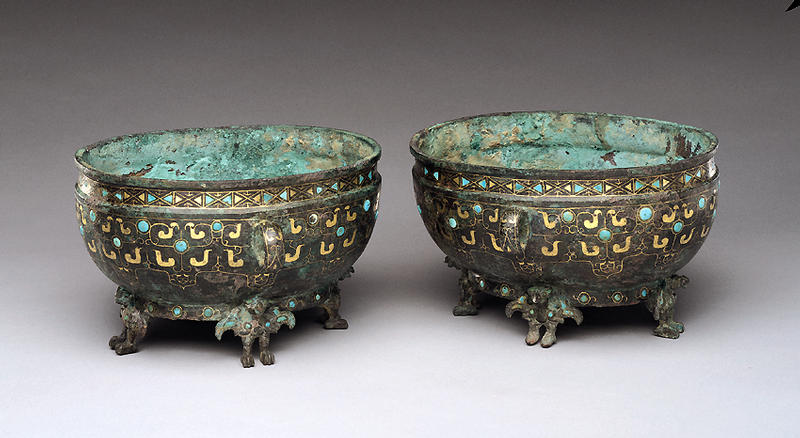Pair of Oval Bowls
- China
- China, Eastern Zhou period
- 5th to 4th centuries B.C.
- Bronze with turquoise, gold foil and wire inlays
- H-10.4 D-17
Catalogue Entry
Drinking cups were key elements of court and religious rituals where wine figured prominently. It is possible that these two nearly identical bowls once served this function. Their shape is unique to the Eastern Zhou period, and it may have developed from drinking cups in other materials.1 However, similarly shaped vessels with lids might have had other functions (compare cat. no. 86).2
These bowls' pattern of fine lines accented by comma shapes--inlaid with gold foil and wire--anchored by round turquoise circlets is refreshingly simple. Although similar gold-inlaid designs appear on other fifth-century vessels and fittings, none exploits the contrasting colors of gold and turquoise as boldly as the one on these vessels.3 The ring handle without gold inlay on one of the bowls is a recent restoration.
The four birds cast separately and soldered on the foot ring of each bowl are most unusual. Because of their frontal pose with spread wings, the strong beaks and talons, and the bright turquoise accents on the wings, they have been compared with predatory birds that are often identified with seminomadic peoples who lived north and west of China's borders.4 Similar birds carved in wood as harness ornaments, excavated from a sixth to fifth century B.C. nomadic tomb at Bashadar in southern Siberia, may be distant prototypes/ancestors.5
Both the distinctive gold-inlaid designs and birds with pronounced beaks and talons can also be associated with bronzes or decorated clay molds from Houma Niucun, Shanxi province.6 Throughout the sixth and fifth centuries B.C., trade between the workshops in Houma and the tribes living beyond their northern frontiers encouraged the borrowing of northern decorative ideas and motifs,7 which might have inspired the bird-shaped legs of these two bowls. But in crossing the frontier, the fierce northern predators were replaced instead by images of elegant creatures with exotic plumage. Fanciful birds supporting an inlaid bronze hu vessel and the mount of a jade cong from a second-century B.C. tomb in Lianshui, Jiangsu province, indicate the longevity of this motif.8
JFS
1. Mackenzie 1991, p. 7; So 1995, no. 53.
2. See So 1995, nos. 58-61.
3. Ibid., pp. 46-47.
4. Mackenzie 1991, p. 8; Tokyo National Museum 1981, nos. 4, 25.
5. Zavitukhina and Barkova 1978, no. 64.
6. Kelley and Ch'en 1946, pls. 44-46; Shanxi sheng 1993, pls. 189-92; So 1995, p. 43.
7. So 1995, chap. 4.3; Bagley 1996.
8. Kaogu 1973.2, pl. 9.1; p. 82, fig. 3.2.
